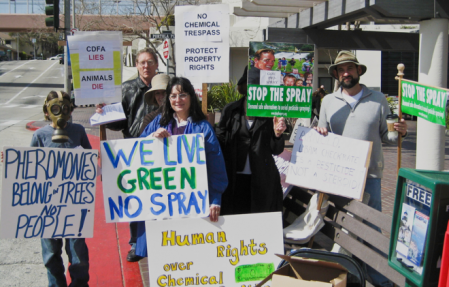Related articles:
– Governor Schwarzenegger Backed Immoral Sex Pheromone Spraying Continues…
– Plan To Spray Toxic Biological Chemicals Over San Francisco Announced
Note to the government: When you unilaterally send aircraft to spray unfamiliar chemicals over residential areas, the public will get very worried.
Environmental activists will pick through mounds of official documents in an attempt to make sense of what you are doing: Will it affect our health?
Since material safety data sheets can make even the most benign molecules sound terrifically dangerous, vigilant citizens will express their concern about rather innocuous substances — damaging their credibility with the scientists who should listen to their objections — and making it hard to sort out any real threats. In some cases, the wording of those documents is so alarming that it could give activists reason to believe that the spraying is part of a mind control program.
Excerpt from LBAMspray.com:
Check this MSDS from Dupont one of the 3 ingredients listed includes “1,2-BENZISOTHIAZOLIN-3-ONE” which is in LBAM-F. See Page 2 under “Potential Health Effects” “SIGNS AND SYMPTOMS EFFECTS OF ACUTE OVEREXPOSURE: High oral doses can cause apathy (lack of feeling or emotion).”
Even if you have the best intentions, to eradicate a tiny moth that could destroy dozens of fruit crops, be prepared to explain your plans, and seek the approval of the public, before getting started with such a controversial program.
Example
Early last year, the California Department of Food and Agriculture became aware that light brown apple moths, Australian pests, had reached twelve counties around the San Francisco Bay Area. Citing studies that the creatures could devastate fruit crops, they launched an aggressive and multifaceted effort to eradicate them.
In addition to spraying the natural pesticide spinosad, covering infested plants in a bacteria that destroys the moth larvae, and releasing wasps that prey upon their eggs, the agency began dropping tiny plastic pellets from low-flying aircraft. Those capsules are infused with two pheromones, chemicals that can confuse the moths and prevent them from mating.
From an academic point of view, the government approach is a textbook case of integrated pest management, which has the best of intentions — to get rid of the bugs without using the most toxic types of pesticide. But activists regard the unchecked release of chemicals over their homes as a violation of their civil liberties and a potential threat to their health.
“This issue is about our rights,” says John Russo of Stop the Spray. “It is our body, and our decision. We have a right to determine what happens to our own bodies.”
On Tuesday, the California Senate Agriculture Committee will review a bill that could put a halt to the spraying. Russo and other activists will be there.
Photo: ColorSync / flickr
By Aaron Rowe
June 15, 2008
Source: Wired
